ASOS: Optimizing customer preference using Machine Learning

ASOS is a British major fashion and cosmetics e-commerce company, the blog highlights the use of machine learning to drive customer preference and personalization.
ASOS is a British major fashion and cosmetics e-commerce company, with more than 26.4 million active customers worldwide and 850+ brands with >100K products on the platform at any one time. ASOS was born with the idea “Buy what you see on film and TV” as it sold exclusively the imitations of clothing seen on red carpets, TV or movies.
The retail giant’s secret to success is focus on the customer experience and innovation. It has become the go-to shopping destination for TikTok & Instagram generation. ASOS leverages advanced analytics- Artificial Intelligence (AI) & Machine Learning (ML) to not only adapt to changing consumer behaviors & preferences but also to redefine the customer experience. Such that as many retailers struggled during COVID-19 crisis but ASOS reported a 329% increase in before-tax profits and a 19% increase in global retail sales as its final year results for 2020.
The AI team at ASOS uses ML to improve the customer experience, improve retail efficiency and drive growth. In this blog two features will be highlighted which uses AI & ML capabilities that create value by making the shopping experience more efficient for customers as well as helps in capturing value for ASOS.
Profile Builder Feature –
The Profile Builder is an AI-based solution that allows customers to provide specific information on their style preferences. This information enables to create a personalized experience for the customers and provide more relevant recommendations. Since it is cumbersome for customers to browse through 1000s of items, so a small representative sample is selected to be used in the Profile Builder. The idea is which products should be shown to learn the most about the customer’s preferences and maximize the value capture by increasing the chances for customers to purchase. Each product is represented in a vector obtained from an algorithm called collaborative filtering.
Collaborative filtering learns a vector based on customers’ interactions with products. Customers that purchase the same items often tend to have similar taste. Collaborative filtering takes into account the views, products added to bag or any other information that has high predictive power such that a machine learning technique known as clustering is implemented. Clustering performs a grouping of a collection of products so that they are in the same group (called a cluster) — items in a cluster are similar to each other, thereby transforming it into embeddings for each product and customer. A key property of these embeddings is that similarity in the embedding space (according to some similarity function) encodes similarity between products or a preference between users and products.
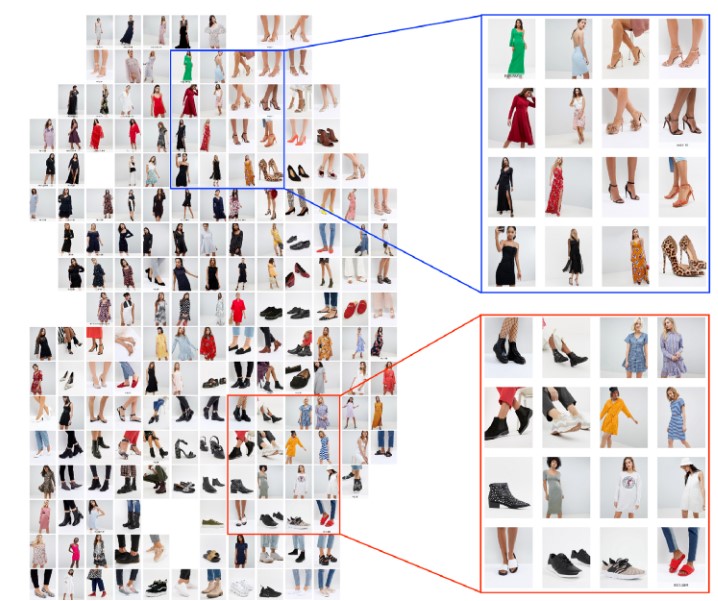
By creating a grouping of 36 different clusters, and one product per cluster is selected and a desired list of 36 products is presented to the customer based on their preferences. Through this method ASOS leverages machine learning to help its customers find their dream product by providing high-quality personalization through multiple touchpoints during the customers’ journey.
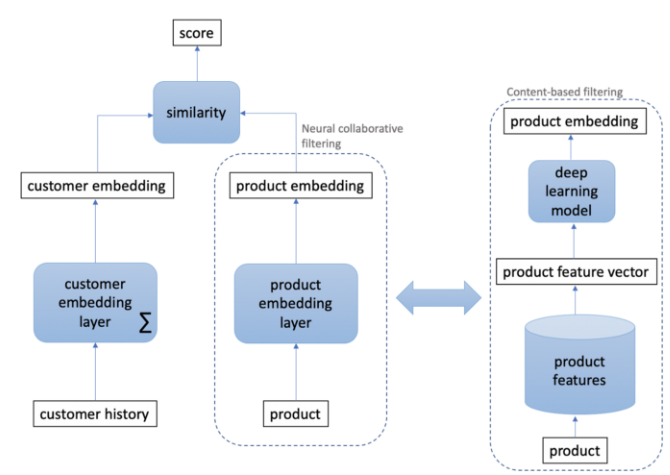
Buy the Look (BLT) feature –
ASOS took their personalization approach to the next level by developing an outfit recommendation tool. Instead of simply recommending similar items, the outfit generation tool recommends complementary items – a much more complicated task.
Combining items of clothing into an outfit is a major task in fashion retail, it requires an understanding of style, color, shape, pattern, fabric, fashion trends, customers’ style preferences and the occasion on which the outfit will be worn. For example, if someone is viewing for party outfit, in the recommended products section the primary image customers might see matching high heels, evening bags and jewelry.

To tackle this ASOS incorporated a Machine Learning tool that consists of a multilayer neural network fed by visual and textual features such as images, text descriptions and categorical attribute to learn embeddings of items and compatible items of different types are embedded close to one another. In other words, it analyzes and groups together items based on attributes, which match stylistically and can be worn together.
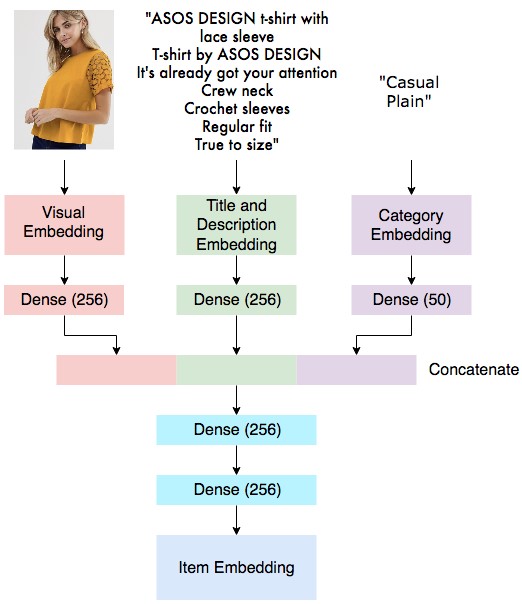
The ML model is trained such that each training example consists of one outfit made up of a set of ASOS products. ASOS utilizes an internal Buy the Look (BTL) dataset which provides almost 600,000 outfits curated by ASOS stylists. The dataset is taken from ASOS product description pages so every product in the catalogue appears once as a seed product. New outfits can be generated by sequentially adding items and re-scoring i.e., each outfit made up of a seed product and a variable number of styling products (e.g., a dress may be styled with a pair of shoes and a bag). An outfit template is designed which is a set of product types with which to complete the outfit. The aim is to find the set of items of appropriate product types which maximizes the outfit score.
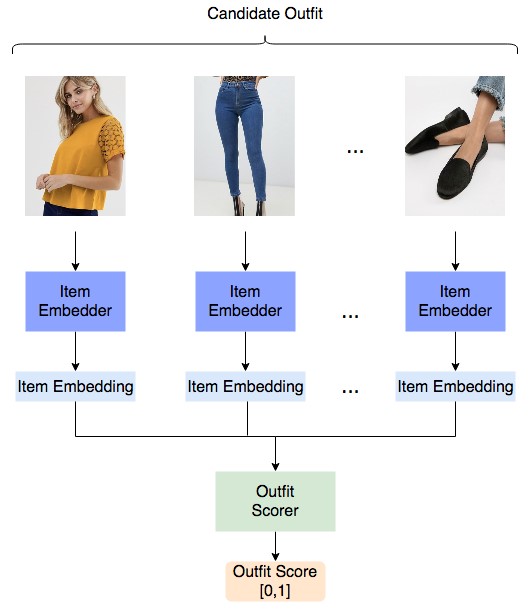
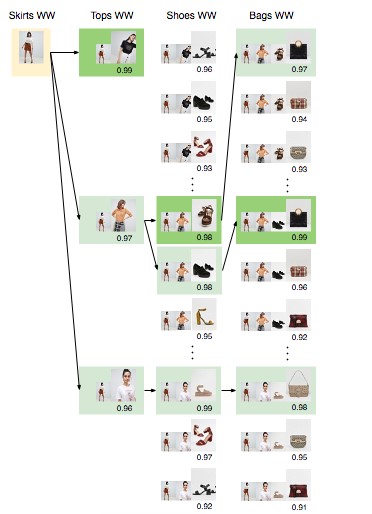
Challenge and the change ASOS had to make to address the challenge
In the fiercely trend-driven fashion world, the company needs to produce data models as quickly as possible. ASOS adds about 5,000 new products every week to a catalog of 85,000 items as trend cycles are getting shorter.
ASOS ML modelling involved three specialized teams (Data science team, big data team & Inferencing team) working in three disparate data stacks. Waiting for one team to complete its part of a project blocked the other two, and end-to-end testing across the three stacks complicated the iteration cycles as models evolved. It typically took six months to bring a new model online. The main challenge is to accelerate this pace.
The ASOS teams wanted tools that would help them accelerate the modelling process and a new, enterprise-wide ethos—breaking down barriers for teams and developing best practices for dealing with data science and modelling. By standardizing on Microsoft Azure Machine Learning service & by unifying the tech stack, thereby bringing ASOS engineers together, ASOS was able to reduce time-to-market for a recommendations model that increased marketing agility from six months to about six weeks. Additionally, it also helped data scientists to not to worry about ML infrastructure, and spend time focusing on their models and running experiments.
ASOS is a great example of a company that uses AI as an improvement of its business process and its relentless focus on customer. As these AI methods are set to be revolutionary in driving sales but also in decreasing the volume of returns for online retailers, which directly impact sales revenue and profit.
Source:



Thanks for the article, Isha. ASOS is a terrific example of a company that leverages machine learning for custom curation; it’s done a terrific job keeping up with fast-paced trends in the industry. I look forward to seeing how ASOS leverages machine learning for retail price optimization, especially during promotional offers (common in fashion e-commerce) based on individual’s historical purchasing data and elasticity modeling. I’d also like to see how AI can address the industry’s return management issue – I agree with you – it’s a challenge that ASOS and the broader industry needs to address, but the retailers seem to think it’s just the cost of doing business. From organizational charts I’ve seen, few fashion companies devote a single divisional unit to returns management – creating further lack of ownership and transparency into its root causes.
Thanks for this post! I love shopping on ASOS – the 2 day shipping especially makes it hard to resist. As an avid user, I can see how their technology has improved over time, but I also think there is a lot more they can be doing from a filtering perspective. With over 100K SKUs, going through the website is a mess and with the amount of things I have bought from and returned to ASOS, they should have a really clear profile of me and a strong picture of what I like within a 80% confidence interval. They have definitely come a long way and I look forward to seeing how they continue to leverage technology to improve their platform.
Thank you so much for this blog post! It is impressive how ASOS is using AI and machine learning to improve the customer experience. I am a little shocked how openly they discuss their AI system and approach. It makes me wonder how far the competition is with implementing something similar. Is this unique to ASOS and is it a competitive advantage or are other companies at the same level wir AI and ML? I am also wondering if they could use these models even more to personalize the user experience. For example – if a user always returns items due to the wrong size, they could offer a service of making sure that what the user buys actually fits. It might be possible to understand what could fit by analyzing what customers return and do not return. This would also help to decrease the number of returns.
Super interesting, thanks for the post. I was not aware of this interesting application of AI/ML. Based on my reading of the post, ASOS is limiting AI/ML applications to profile building of its customers and the Buy The Look feature. I wonder if they can take ML/AI a step further and apply it to their and their partner’s manufacturing processes to reduce cost and increase efficiency, while also applying the technology to help in the creative process of designing the latest apparel.
This is fascinating Isha! AI in fashion feels like it’s been a long time coming, and I’m surprised more e-commerce brands aren’t leveraging it. I tried to find out what brands like Farfetch are doing, brands that were hailed in the industry for digitizing early, and there seems to be a slow pick up of AI specifically, even from those brands. ASOS being as adaptable and fast moving as it is feels a great candidate to lead the way.